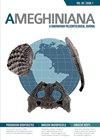Maastrichtian Microfossils of the Shallow Marine Umir Formation, Northeastern Colombia
IF 1.5
4区 地球科学
Q3 PALEONTOLOGY
引用次数: 0
Abstract
Abstract. During the Late Cretaceous, northern South America was characterized by broad epicontinental seas, with variable surface productivity and changing bottom-water oxygenation. Global sea-level fluctuations and local tectonic shifts caused their disappearance in the latest Cretaceous. We present an integrated micropaleontological and geochemical study of a section comprising the Umir Formation and its lower stratigraphic contact with the La Luna Formation, in the Middle Magdalena Valley, northeastern Colombia. Foraminiferal assemblages were moderately diverse and mainly dominated by benthic taxa, characterizing the biozones Siphogenerinoides bramlettei and Ammobaculites colombiana (Maastrichtian). Planktonic foraminiferal assemblages were less diversified, being species assigned to Heterohelicidae and scarce keeled forms (Globotruncana spp.) the most recurrent taxa. Ostracod recovery was very scarce, and we could only identify the genus Actinocythereis. In contrast, calcareous nannofossil assemblages were moderately diversified along the section, and composed of typical Late Cretaceous low-latitude taxa such as Micula staurophora, Cribrosphaerella ehrenbergii, Gartnerago segmentatum. The identified microfossils indicate a transition from middle-inner shelf conditions, with moderately oxygenated bottom waters within the La Luna Formation, to a shallower marine setting within the Umir Formation. This interpretation is supported by Sr/Ba and log(Fe/Ca) ratios measured in bulk sediment, which indicate increased continental runoff and terrigenous input in the upper part of the section. Moreover, a significant biotic turnover was identified at the base of the section, suggesting the presence of a xenoconformity at the La Luna-Umir contact, which has been previously described and proposed as a regional stratigraphic feature. Resumen. El Cretácico Tardío del norte de Sudamérica estuvo dominado por mares epicontinentales extensos, con fluctuaciones de la productividad superficial y oxigenación del agua de fondo. Cambios en los regímenes tectónicos locales y descensos globales en el nivel del mar, llevaron a la desaparición de dichos ambientes hacia fines del Cretácico. Presentamos un estudio micropaleontológico y geoquímico integrado de una sección de la Formación Umir y su contacto basal con la Formación La Luna en el Valle Medio del Magdalena, noreste de Colombia. Las asociaciones de foraminíferos fueron moderadamente diversas y estuvieron dominadas por formas bentónicas que definen las biozonas de asociación locales Siphogenerinoides bramlettei y Ammobaculites colombiana (Maastrichtiano). Las formas planctónicas, menos diversas, incluyeron ejemplares de Heterohelicidae y escasas formas quilladas (Globotruncana spp.). El registro de ostrácodos fue muy escaso, sólo pudimos reconocer al género Actinocythereis. En contraste, las asociaciones de nanofósiles calcáreos fueron moderadamente diversas y comprendieron formas típicas de bajas latitudes del Cretácico Tardío como Micula staurophora, Cribrosphaerella ehrenbergii, Gartnerago segmentatum. Las asociaciones de microfósiles indican una transición de condiciones de plataforma media-interna, moderadamente oxigenada en la Formación La Luna, a un ambiente más somero en la Formación Umir. Esta interpretación es corroborada por las relaciones de Sr/Ba y log(Fe/Ca) del sedimento que indican un aumento en la escorrentía continental y el aporte de terrígenos hacia la parte superior de la sección. De igual forma, la variación significativa en las asociaciones de microfósiles hacia la base sugiere la presencia de una xenoconformidad en el contacto La Luna-Umir, que fue previamente reportada como de carácter regional.哥伦比亚东北部浅海Umir组的马斯特里赫特微化石
摘要。晚白垩世期间,南美洲北部以广阔的陆表海为特征,地表生产力不同,底水氧气变化。全球海平面波动和局部构造变化导致它们在最新白垩纪消失。我们对哥伦比亚东北部中马格达莱纳河谷的一个部分进行了综合的微古生物学和地球化学研究,该部分包括Umir地层及其与La Luna地层的下地层接触。有孔虫组合略有多样性,主要以底栖类群为主,表征了哥伦比亚(马斯特里赫特)的Siphogenerinoides-Bramlettei和Ammobaculite生物带。浮游有孔虫组合的多样性较小,被分配到异螺旋体和scarce keled forms(Globotruncana spp.)是最常见的分类群。牡蛎的回收非常稀缺,我们只能识别放线菌属。相比之下,整个剖面的钙质超微化石组合略有多样化,由典型的晚白垩世低纬度类群组成,如Micula staurophora、Cribrosphaerella ehrenbergii、Gartnerago segmentum。已鉴定的微化石表明,从月球地层中具有中度氧化底水的中内陆架条件过渡到UMIR地层中的浅海环境。这一解释得到了在散装沉积物中测量的SR/BA和LOG(FE/CA)比率的支持,这些比率表明该部分上部的大陆径流和陆源输入增加。此外,在该部分的基础上确定了一个重要的生物转折,表明La Luna-Umir接触中存在异种整合,该接触以前被描述和提议为区域地层特征。总结。南美洲北部晚白垩世以广阔的陆表海为主,地表生产力波动,底水充氧。局部构造格局的变化和全球海平面的下降导致这些环境在白垩纪末消失。我们对哥伦比亚东北部马格达莱纳河谷中部的UMIR地层的一部分及其与La Luna地层的基线接触进行了综合的微考古和地球化学研究。有孔虫的协会略有不同,以底栖形式为主,这些底栖形式定义了哥伦比亚(马斯特里赫特)的当地Siphogenerinoides-Bramlettei和Ammobaculites协会的生物区。浮游生物的形式不太多样,包括异螺旋体和稀疏的龙骨形(Globotruncana spp.)。牡蛎的记录非常罕见,我们只能识别放线菌属。相比之下,钙质纳米化石的组合略有不同,包括晚白垩世低纬度的典型形式,如Micula Staurophora、Cribrosphaerella Ehrenbergii、Gartnerago Segmentum。微化石组合表明,从月球形成中的中-内平台条件(中度含氧)到UMIR形成中的浅环境过渡。沉积物的Sr/Ba和Log(Fe/Ca)关系证实了这一解释,这些关系表明大陆径流增加,陆源向剖面顶部的贡献增加。同样,微化石与基底的关联发生了显著变化,这表明月球-UMIR接触中存在异种整合,此前曾被报道为区域性的。
本文章由计算机程序翻译,如有差异,请以英文原文为准。
求助全文
约1分钟内获得全文
求助全文
来源期刊

Ameghiniana
地学-古生物学
CiteScore
2.50
自引率
10.00%
发文量
21
期刊介绍:
Ameghiniana is a bimonthly journal that publishes original contributions on all disciplines related to paleontology, with a special focus on the paleontology of Gondwana and the biotic history of the southern hemisphere. Published yearly since 1957, it has undoubtedly become the main palaeontological publication from Latin America. Ameghiniana has recently broadened its editorial board, reorganized its production process, and increased to a bimonthly frequency, which resulted in a significant decrease in the turn around time.
 求助内容:
求助内容: 应助结果提醒方式:
应助结果提醒方式:


